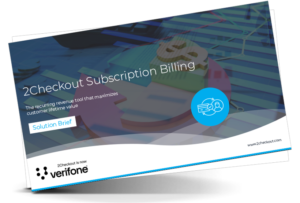Today’s consumers are not just looking for products and services; they seek experiences tailored to their unique needs and values. Personalization is the future (and the present) of marketing. Sustainability is also a major deciding factor.
Subscribers across various sectors are increasingly vocal about their desires. They seek products and services that not only cater to their individual needs but also align with their environmental consciousness.
This new focus on personalization and sustainability means businesses must adapt to stay relevant and succeed. Let’s take a closer look at why personalization and sustainability are now essential and no longer just extra perks.
The Growing Importance of Personalization
Personalization in subscription services refers to customizing content, recommendations, and user experiences based on a customer’s demographic, socioeconomic, and behavioral data. Some of the data points used to personalize content include:
- Age (demographic)
- Purchase history (behavioral)
- Location (demographic)
- Browsing history (behavioral)
- Education level (demographic)
- Gender (demographic)
Personalization creates a unique experience for each subscriber, making them feel understood and valued. Here is why; personalized experiences significantly enhance user engagement and satisfaction. When subscribers feel that a service understands their needs and interests, they are more likely to continue using it.
Personalized experiences help services stand out, fostering loyalty and reducing churn rates. Subscribers are more likely to continue using a service that feels uniquely catered to them. Data shows that 80% of consumers are more inclined to purchase from brands that provide relevant offers and recommendations.

In addition to the above, here are more benefits of personalizing your subscription services:
- Personalization can improve overall brand perception, as it shows a commitment to understanding and catering to customer needs.
- It can lead to higher conversion rates, as personalized recommendations are more likely to resonate with subscribers.
- Personalized services can command higher pricing, as customers are often willing to pay more for customized experiences.
If you’re not sure how to approach personalization efforts properly, don’t worry—75% of marketers say personalization increases engagement, and they’re always willing to share nuggets of knowledge with those willing to listen.
Case Study: Successful Personalization in Subscription Services
Netflix’s implementation of personalization in its subscription service is a prime example of leveraging data and technology to enhance customer experience and business success.
Netflix collects data from your interaction with their service, including what you watch, when you watch, how often you pause or stop a program, and your ratings. This data feeds into sophisticated machine-learning algorithms that analyze user patterns and preferences.
Netflix then designs highly personalized content recommendations for you based on this data. This means your homepage, genres, and even search results are unique. The algorithms predict not only which titles you might like but also the likelihood of you watching a new series or movie.
The user interface is constantly adjusted based on individual user behavior. For instance, the artwork displayed for a show or movie might change based on what the algorithm believes a particular user is more likely to click on. Even the previews and teasers are tailored to individual tastes.
This is all possible because Netflix’s system is designed to continuously learn from user interactions. If a user starts a series but doesn’t finish it, the system adjusts its recommendations accordingly. Netflix constantly works on balancing personalization to ensure users are exposed to a variety of content and not just what aligns with their past behavior.
That way, they are more likely to stay subscribed if they regularly discover content that interests them.

Sustainability: A Non-Negotiable Feature
Sustainability has become a non-negotiable feature for many subscribers and companies due to a growing awareness of its importance in preserving the environment.
The increasing impact of climate change and consumer awareness drives this trend. People are more conscious of their purchasing decisions and their effects on the planet.
This is especially crucial for subscription box services. While these services offer convenience, they have raised concerns about their environmental impact. One of the significant issues is excess packaging, often resulting in increased waste and resource consumption.
For instance, research indicates that meal kits can reduce food waste and carbon emissions through more accurate portions, but they still contribute to excess packaging waste.
This is a challenge faced by the entire e-commerce and subscription box industry. Furthermore, the beauty and fashion industries within the subscription model also contribute to the problem, with a significant increase in single-use plastics consumption and a lack of infrastructure to manage the high levels of packaging waste.
Companies can minimize these environmental impacts by adopting more sustainable practices. This includes using recyclable materials, reducing packaging, and optimizing delivery routes to lower emissions.
Case Study: Incorporating Sustainability in Subscription Services
Green Kid Crafts is one of the few brands that has effectively integrated sustainability into its subscription service.
The company is committed to using recycled materials, ensuring their boxes and packaging are safe and eco-friendly. They also emphasize educating children about environmental issues by creating boxes with sustainability-focused themes, such as Alternative Energy and Ocean Conservation.
In addition to promoting eco-friendly practices, Green Kid Crafts also commits to carbon neutrality by offsetting the carbon dioxide emissions generated by their business activities. This is done in partnership with organizations like CarbonFund. This helps them positively contribute to climate change education and emission reduction efforts.
They are also partnering with OneTreePlanted to plant a tree for every box they sell, which is a great way to contribute to global reforestation initiatives.
The company also focuses on slow and steady growth, prioritizing sustainable practices and developing partnerships that share their environmental values.
This approach helps Green Kid Crafts succeed in being eco-friendly and teaching kids about sustainability. They mix environmental lessons with enjoyable activities, making their subscription service a favorite among families who care about the planet.

Other Key Features on the Subscribers’ Wishlist
In addition to personalization and sustainability, subscribers are also keen on other key areas to improve their experiences in 2024. Here are some of the features that will rock this new year:
- Flexibility and convenience. Subscribers are now more keen on simple and easy customization services. They want easy sign-up processes, user-friendly interfaces, and good customer support for a smooth experience. If you include only small additions, like QR code registration and Linktree links, it might save just a few clicks, but those few clicks add up to hours after a while, and subscribers appreciate the straightforwardness.
- Quality and affordability. Subscribers expect top-notch quality in products and services. This focus on quality ensures that they feel their investment in a subscription is worthwhile, leading to greater satisfaction and loyalty. While seeking quality, subscribers also prioritize value. A slight overpay isn’t the end of the world, but pushing things too far can have negative consequences.
- Security. With increasing online threats, subscribers want assurance that their personal data is secure. Robust privacy measures and data protection are crucial for trust in subscription services. Even a small scandal or mishap can tarnish your brand’s reputation.
- Integration with technology. Users expect seamless integration with their existing tech. For example, a fitness app should sync with wearable devices, or a music streaming service should be easily accessible on various smart devices. This integration makes using the service more convenient and enhances the overall experience.
Predicting Future Trends in Subscription Services
The future is bright for subscription services. To stay relevant, you must keep up with the trends and adjust to match consumer needs. Here are some key trends to look out for:
Global Expansion
The world is now becoming a global village. Brands must now adapt to diverse cultural preferences and offer multilingual support. This will ensure accessibility to a worldwide audience.
Brands should start incorporating more localized content to appeal to regional tastes, especially in media and entertainment. They’re also integrating various international payment methods and complying with local regulations in different countries. For instance, if you deal with SaaS services, you can use SaaS online payment solutions to accommodate people paying from other parts of the world.
For physical product subscriptions, efficient and effective international shipping strategies are crucial. This expansion strategy involves creating tailored marketing efforts for different global markets, considering each region’s unique cultural nuances and consumer behaviors.
Flexible Subscriptions
subscription services should be highly adaptable to meet individual customer needs. This trend involves offering subscribers the choice to customize aspects like delivery frequency, product selection, and payment options.
It allows customers to pause, modify, or cancel their subscriptions easily, providing greater control over their subscription experience. This approach aims to increase customer satisfaction and retention by accommodating diverse lifestyles and changing preferences.
Technological Innovations
Technological changes are already reshaping the marketing industry. In fact, 34% of companies are already using AI in their marketing efforts — and another 42% are looking into how they can use it.
Today, some brands already use augmented reality (AR) and virtual reality (VR) to make subscription services more immersive and interactive. Some are also using AI for better personalization by predicting what customers like.
These tech advancements are improving how customers use these services and creating new ways for companies to engage with them.

Conclusion
The significance of personalization and sustainability in the subscription service industry is immense. They are crucial in meeting and surpassing the expectations of subscribers.
Businesses offering subscription services should integrate these elements to stay competitive and relevant to consumers. Adopting personalization and sustainability is not just good for business; it’s what customers now expect and value.
Ready to turn subscriber wishes into reality? Explore how 2Checkout’s Subscription Billing can personalize your offerings and ensure sustainability for your business. Transform your subscription model today!






